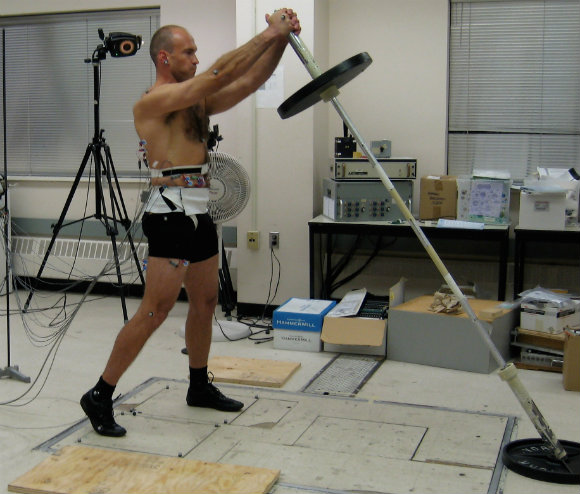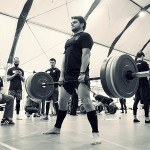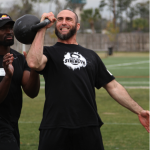By now, proper abdominal training should not be a mystery. The body of experience and scientific knowledge serve up powerful methods on a platter — yet they get lost in the Internet noise.
Perhaps a fashionable “list article” will catch your attention? With apologies to Rob Lawrence, who rightfully despises list articles as “snack food for the mind,” here is my list of ab dont’s:
1: Chasing the “Burn”
The “burn” is just a manifestation of mounting acidity produced when one is in the glycolytic energy pathway, the choice pathway for amateur coaches more interested in “smoking” their victims than in making them strong. Dr. Fred Hatfield famously quipped, “You like burn? — Light a match.”
High levels of tension are prerequisite for making a muscle stronger and the highest levels of it are available for less than thirty seconds — before the burn kicks in.
2: Not Focusing on the Contraction
Your muscle can contract in response to the load (feed-back) or to a command from your brain even in the absence of resistance (feed-forward). Examples of the former are the farmer’s carry and the double kettlebell front squat. Examples of the latter are, the double kettlebell clean, the hard-style sit-up, and power breathing. For maximal strength development both types of training are a must.
Bodybuilders got the feed-forward ab work figured out. They focus on the contraction rather than the reps — and have the abs to show for it. First Mr. Olympia Larry Scott, a master of “mind-muscle connection,” showed me some of his ab contraction techniques. His attention to detail and understanding of anatomy were impressive and his focus was extraordinary. Mr. Scott was the exact opposite of the clowns glued to their phones while doing crunches.

Photo courtesy Prof. Stuart McGill’s Spine Biomechanics Lab at the University of Waterloo, Canada.
3: Not Using Enough Resistance
Feed-back training demands high external resistance. It can be a heavy weight or poor leverage.
Examples of the former include the full contact twist and the one-arm farmer carry. I am not including a weighted sit-up because it is a pain logistically. Getting a stack of 45-pound plates in place and then holding onto them is not something you want to do more than once. Examples of the latter are the dragon flag and the hanging leg raise.
4: Exclusively Isometric Training
Isometrics are very valuable and the role of planks, L-seats, and heavy lifts demanding a strong brace cannot be underestimated. However, experience has taught me that people who have not trained their abs dynamically, a stretch followed by a peak contraction, are not fully aware how to engage them 100% statically. (Of course, such training is not for the flexion intolerant.)
5: Not Making Every Exercise an Abdominal Exercise
An expertly performed heavy deadlift is an exercise in both feed-forward and feed-back tension. Engaging a solid brace before the pull is the former. Staying tight under a moving load is the latter.
Former Mr. Olympia Dr. Franco Columbu told me that because he hated direct abdominal work all he did for his abs was keeping them tight in all lifts. He ended up winning the “Best Abs” award and, more importantly, deadlifting over 700 pounds at a bodyweight of around 180.

Photo courtesy Prof. Stuart McGill’s Spine Biomechanics Lab at the University of Waterloo, Canada
The Ab Training Call to Action
There are many exercises to choose from for effective ab training. The key is to practice both feed-forward and feed-back tension and to say farewell to the “burn.” All of the StrongFirst curricula — kettlebell, bodyweight, and barbell — are obsessive about building strong abs. Consider the Total Tension Kettlebell Complex as an example.
You can always keep it Kettlebell Simple & Sinister. On the given plan the efforts are brief and intense — 10 reps per set in the swing and 1 in the get-up. The get-up has a dynamic spine flexion component that cramps your abbies the way the sit-up never could. Feed-forward tension is addressed through bracing and power breathing. Feed-back tension is taken care of once you persevere to reach at least the “simple” goal. When you wrestle a heavy kettlebell in a single-arm exercise, everything in your midsection cannot help lighting up like a Christmas tree.
Power to your abs!
The StrongFirst Courses and Certifications are great ways to learn the feed-forward and feed-back methods in this article.





I remember the time Pavel hit my abs in the hallow position. The stuff works. How else would a 53 year old keep the abs for the last 10 years or so? I had twins at 40, no tummy tuck. Just smart training. I am not a show off but my fellow comrades tell me I have show stopper abs.
Hi Pavel,
If I was to train the abs 3 times per week with exercises like the full contact twist and hanging leg raises should I incorporate them into my strength sessions or do them on their own in a separate session? Would it be better to train abs on a hard day of training or easier day of training?
Dave, you are more likely to receive an answer to this if you put it in the Discussion Forum, actually: http://www.strongfirst.com/community/
Thank you!
Pavel,
I pretend you train at my gym, and at any time, that you may hit me in the abs. So I stay tight.
Question: For 5×5 DLs, squats, presses, etc, ideal rest is a few minutes between sets. But what’s ideal rest for 5×5 dragon flags, or similar ab work? (I often rest 15 to 45 seconds between ab sets.)
Thank you.
Perhaps this “list comment” will serve as a “chewing gum for the mind” after snacking.
1: Great article!
The folly of burn-chasing and the idea of including some dynamic contractions (flexion intolerance permitting) in my routine are great takeaways. It was the perfect explanation of feedback and feed-forward that really filled a gap in my education though. Not bad for a snackfood article. Could you please help clarify a nuance of feed-forward that previously confused me? Top brass in the FMS have described the ‘glueing’ of the straight leg to the ground during the 2nd stage of the TGU (press to elbow) as feed-forward. But they’ve also described it as reflexive strength, which as I understand it, is the unconscious spinal reflex that occurs during in-line half-kneeling or crawling. So is that stage of the Get Up producing both feedback (reflexive in response to the hand-held weight) and feed-forward (the conscious mental instruction to keep the leg flat, even though it may want to come up)? This chewing gum might really start to lose its flavour with all the questions, but why is keeping the leg flat so important, and which stages of the GU have the dynamic spine flexion component?
2: I’m a big fan
Your books, articles, and introductions to the concepts of other big-hitters in the fitness world have really revolutionised my way of looking at fitness (prioritising strength and functionality over aesthetics, for example). I’m planning to put some of those concepts into practice to revolutionise my body, and am looking forward to reading Simple & Sinister.
pavel I wished I looked as good as you
I liked the list post! 😉
Would ab wheel rollouts have a place on top of bracing on more global exercises (chin ups, KB front squats etc) or would they be redundant?
Carl, sorry, I do not understand the question.
Apologies Pavel.
My question was mainly whether ab wheel rollouts would make your recommended list of effective exercises to target the midsection?
Carl, absolutely. Both feedforward (cramp on the top before descent) and feedback.
Good to hear as it’s one of my favourite moves!
Thanks so much for the responses.
Dear Pavel,
Thank you for the article. One question I have is how do we take care of the abdominal fat around the waist? Does these exercises and techniques take care of that too? Or is that purely diet-related? Or is it a combination of both diet and exercise?
Thanks.
Abdul-Rasheed, that is a matter of diet and endurance type exercise—kettlebell swings, running, etc.
All that content and all you have to say is a comment about Pavel’s weight?
Why does Pavel choose to remain so thin when he has all the knowledge and ability to develop muscles? It seems he would be better suited to pack on 20 pounds of muscle mass. Does he not eat?
Well first Pavel is a tall guy and tall guys look thiner. Carrying more muscles can have negative effect on his complex athletic abilities. I am sure he has the quality&strength and thus has no reason to focus on getting bigger. There is many bigger looking gym folks around, who are the greatest heroes just at one moment- when they sit at a bar with thight shirt and think they look strong and dangerous. But the truth is their self confidence is very low, because they know how much they would suck if they start doing anything. They are out of breath when walking up couple of stairs. They look funny when trying do any ball sport or other coordination and sport activity. And whats most ridicoulous, they are weak when attempting real strength exercises. Pavel calls them “muscleheads”. Because of them the standards in our society of how exercising people should look like have grown up too high. And people carry in their heads this visual connection of all the big are the strong. Sometimes one of the healthiest, strongest and most high quality natural sportsman dont look that impressive at first (due to those visual standards people have), but they trust me- they dont care 🙂
Walt,
I have never met Pavel, so my reply is a sort of guess mainly based on personal experience and having talked to quite a few members of certain professions, whether special forces or koryu sensei.
As we all know it ultimately boils down to the goal of the person – and if a person does want to look like a bodybuilder, fine – he should pick a routine that does exactly that. Some people rather prefer to not look like they can generate a lot of power, remember – a powerlifter looks the way he does because his sole purpose is to lift as much weight as possible. And a bodybuilder does the same, just based on a different goal.
I could imagine that Pavel is more concerned with not looking too huge, and that he rather likes to maintain or increase his output. Most people who are seriously dangerous do not necessarily look like it, whether Special Forces, koryu sensei or mma fighters. Too much of a good thing is still too much.
It is a free country, Walt ;]
Love the full contact twist! They’ve been a staple in my grappling cross-training schemes since college…they emulate directional sprawls (when you actually use them on an opponent) and hip “bump” tosses very well. Nice article Pavel! Would love to hear about any data you and Prof. McGill obtained using this movement…
Thanks, Danny! Prof. McGill liked the exercise as shown—with the pelvis locked to the rib cage but pointed out that many people make the mistake of rotating the spine.
Understood, and thanks for responding. My experience has been positive with respect to my spine by focusing on hip rotation as the bar lowers (similar to the diagonal hip hinge during the TGU and windmill descent), as described in the BJJ S&C article I wrote last year for SF. Cheers!